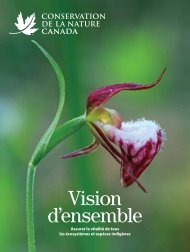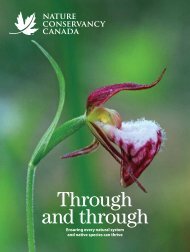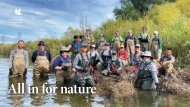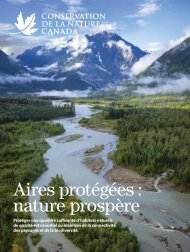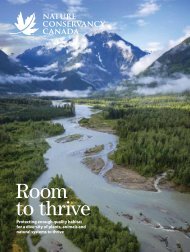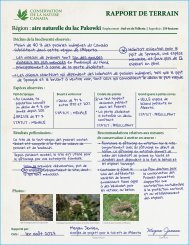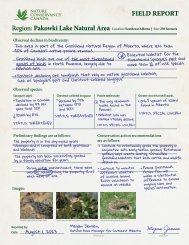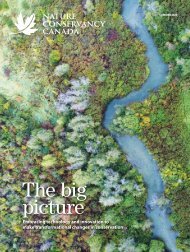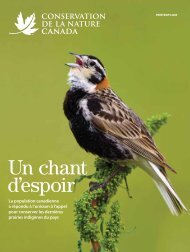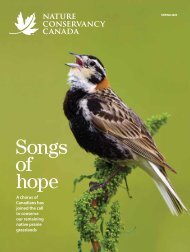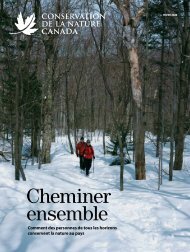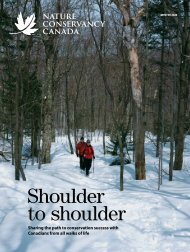Summer 2017 NCC Magazine
You also want an ePaper? Increase the reach of your titles
YUMPU automatically turns print PDFs into web optimized ePapers that Google loves.
T<br />
his spring, Canada Post issued a special stamp featuring<br />
the lakeside daisy, a small perennial in the aster family and<br />
one of Canada’s rarest plants.<br />
STAMP: CANADA POST. MAP: <strong>NCC</strong>.<br />
This bright yellow flower that blooms in early spring is<br />
globally rare and found only along the Great Lakes. In<br />
Canada, it only occurs on the grasslands and pavement<br />
alvars of the Saugeen Bruce Peninsula and Manitoulin<br />
Island in Ontario (bottom right). These populations<br />
of lakeside daisy account for about 95 per cent of the<br />
populations existing in the world. It is also one of<br />
very few plant species with most of its global range<br />
in Ontario.<br />
RARE HABITAT<br />
The lakeside daisy is found mostly in alvars: naturally open areas with either<br />
a thin layer of soil or no soil over a base of limestone or dolostone bedrock. These<br />
globally rare ecosystems are found off the coast of Sweden, the eastern European<br />
Baltic regions, the United Kingdom and the North American Great Lakes Basin.<br />
Alvars support many rare and threatened species, including the lakeside daisy,<br />
with more than 60 per cent of North American alvars located in Ontario.<br />
Lakeside daisies grow on pavement alvars, among a mosaic of exposed rock<br />
covered in lichen and moss. Grykes, joint fractures in the rock shaped by water<br />
erosion, are home to many of the wildflowers, ferns and other plants found on<br />
pavement alvars. Soil accumulates over time in these cracks to allow for plants<br />
such as low calamint, maidenhair spleenwort and lakeside daisy to take root.<br />
This unique habitat is kept open and sunny through natural disturbances such<br />
as drought, fire or wind erosion, which remove taller trees and shrubs that would<br />
otherwise shade out sun-loving plants such as the lakeside daisy.<br />
THRIVING ON ADVERSITY<br />
Like many of the plant and animal species found on alvars, the lakeside daisy is<br />
able to survive harsh conditions: spring floods, summer droughts and temperatures<br />
as high as 52°C. Due to the extreme variations in temperature, moisture and<br />
disturbance on alvars, only specific plants, animals and invertebrates can thrive<br />
in this habitat. A variety of birds, mammals (including deer and rabbits) and insects<br />
eat the lakeside daisy, or its seeds, making it an important part of alvar ecosystems.<br />
A THREATENED SPECIES<br />
The lakeside daisy is listed as threatened under the Endangered Species Act<br />
in Ontario, and threatened federally under the Species at Risk Act, due to loss of<br />
habitat and its small range. Unfortunately, due to the open nature of alvars and the<br />
habitat’s abundance of limestone rock, they are prone to development. Lakeside<br />
daisies are also found along shorelines and inland areas that are popular for hiking<br />
and recreation, where they can be accidentally trampled.<br />
The Nature Conservancy of Canada (<strong>NCC</strong>) has protected significant alvar<br />
habitat, including habitat for the lakeside daisy, on Manitoulin Island. There are<br />
significant populations of this plant found on <strong>NCC</strong>’s Tasker Wilderness Shore<br />
property on Manitoulin. <strong>NCC</strong> is also working to control gold-moss, an invasive<br />
plant that threatens the lakeside daisy.1<br />
FACT SHEET<br />
SCIENTIFIC NAME<br />
Tetraneuris herbacea<br />
SIZE AND WEIGHT<br />
This perennial plant can grow up<br />
to 35 centimetres tall.<br />
RANGE<br />
The lakeside daisy is restricted to the<br />
Great Lakes region of North America<br />
and is present in Ohio, Illinois, Michigan<br />
and southern Ontario.<br />
POPULATION TREND<br />
The total size of the Canadian<br />
population has not experienced<br />
significant changes; however,<br />
populations that have been monitored<br />
in the most heavily travelled areas<br />
are declining noticeably.<br />
STATUS IN CANADA<br />
Threatened both federally<br />
and provincially.<br />
DID YOU KNOW?<br />
Alvars provide habitat for many<br />
at-risk and globally rare species.<br />
The Saugeen Bruce Peninsula and<br />
Manitoulin Island support some of<br />
the best examples of alvar habitat<br />
in the world, and are key areas for<br />
conservation in North America.<br />
Elliot Lake<br />
Gore Bay<br />
Lake Huron<br />
Manitoulin<br />
Island<br />
Killarney<br />
Tobermory<br />
Ontario range<br />
Species occurrence<br />
• Species recorded on <strong>NCC</strong> property<br />
Sudbury<br />
Georgian<br />
Bay<br />
Owen Sound<br />
Parry<br />
Sound<br />
natureconservancy.ca<br />
SUMMER <strong>2017</strong> 13



